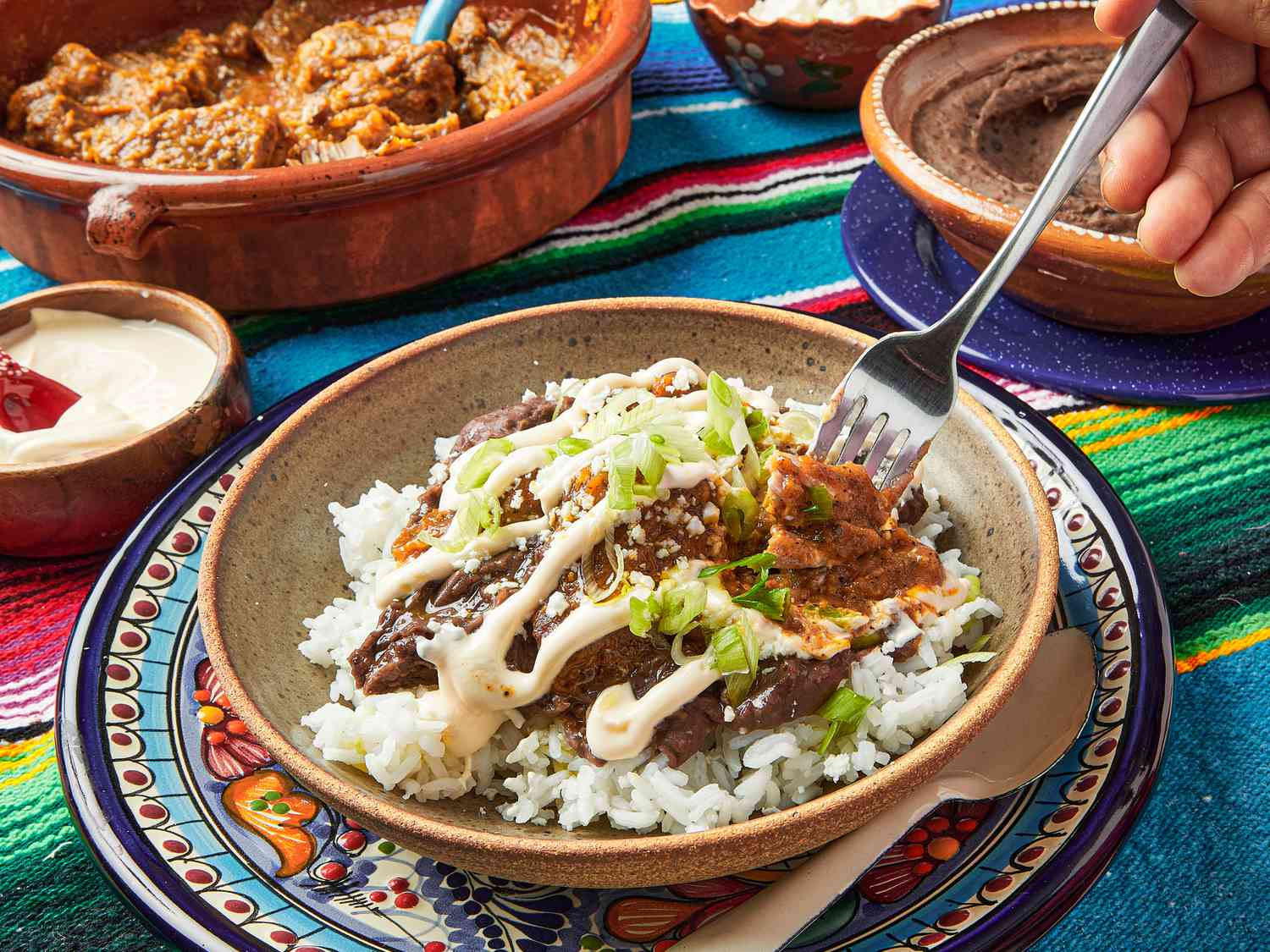
Why It Works
- Steaming the ribs produces tender meat and ensures the bones slide out easily.
- Charring the salsa ingredients before blending adds smokiness to the dish.
As a kid, I hated saucy food. Chills went up my spine whenever my foods touched one another on the plate; so, I actually dreaded when my family made morisqueta, the dish of white rice smothered with saucy pork ribs, beans, crema, and queso. I missed out on years of enjoying this hard-to-find specialty from the state of Michoacán in Mexico.
Serious Eats / Lorena Masso
My dad, who was born in Michoacán, loves morisqueta so much that he playfully calls my mom Norisqueta—her name is Nora. About three years ago, after years of coaxing from my family, for the first time I loaded up my plate with the ribs, salsa, beans, and rice dish—I instantly understood the hype. The smoky salsa of charred tomatoes, fresh chiles, onion, and garlic blankets the tender ribs and seeps into the fluffy white rice. While a beige sauce over brown ribs with simple beans and white rice appears humble, all of these components together add up to an intensely rich, smoky, and savory meal.
The Difference Between Mexican Morisqueta and Filipino Morisqueta
This version of morisqueta is from the Mexican state of Michoacán, but there is also a popular fried rice dish called morisqueta tostada in the Philippines. Mexico and the Philippines were both colonized by the Spanish and linked by the Manila galleon trade route between Manila and Acapulco. Which morisqueta came first is disputed, but there is some evidence that the name itself is from the Philippines. A US document from 1902 states that Spanish colonizers in the Philippines referred to white rice as morisqueta. In Mexico, the dish is also sometimes referred to as zambaripao, a word that is Filipino in origin.
But besides the identical name, its Spanish roots, and the use of rice, the two countries’ versions of the recipe don’t share many similarities. Filipino morisqueta is made by frying rice along with sausage, ham shrimp, green onion, and eggs. It’s a delicious dish, but one that has a lot more in common with Chinese fried rice than Mexican morisqueta.
Tips for Memorable Morisqueta at Home
Choose fatty ribs. Morisqueta Michoacána is typically made with bone-in pieces of pork ribs known as “trocitos de costilla.” You’ll also find them labeled as spareribs for stew. They’re spareribs that have been cut into one-bone sections and halved crosswise into roughly three-inch long chunks. They’re cut from near the belly, as opposed to baby back ribs which are cut from near the spine. They have more meat and fat on them than baby back ribs. I prefer thicker, fattier ribs as thin, lean ribs are likely to dry out.
Serious Eats / Lorena Masso
You can find trocitos de costilla at many Latin grocers, but if you can’t find the ribs precut, you can purchase one roughly 2 1/2 pound rack of spareribs and have your butcher cut them for you, or cut them yourself at home (though you’ll need a sharp and sturdy cleaver for that). Or, if you don’t feel like dealing with bones at all, you can use boneless country-style ribs. You can also swap the meat for chunks of panela cheese to make a traditional vegetarian variation.
Steam the ribs. The ribs are usually cooked on the stovetop by submerging them in a small amount of water and simmering until they’re tender and the cooking liquid evaporates. Once the liquid dries up, the ribs continue to cook until they are crisped by their own rendered fat. It sounds like a fairly simple one-pot rib cooking technique, but I find this method to be imprecise; you have to guess exactly how much water you need, and top it off with more water throughout cooking, plus the meat can easily overcook. Instead, I gently steam the ribs until they’re tender when poked with a knife. You can also test them by gently pulling on the bone of one of the ribs. If the bone easily pops out with a bit of wiggling, the ribs are ready. Once the bones are removed, it’s also a good idea to check for any remaining small bits of bone and remove them using kitchen shears. If you prefer, you could also skip this step of removing the bones and just leave them in and let each diner gnaw the meat from the bones themselves.
Char the salsa ingredients. The ingredients in this salsa are fairly simple and what you would find in a traditional salsa for morisqueta. Some morisqueta recipes,including mine, char the salsa ingredients to develop a complex, smoky flavor. Char the tomato, jalapeño, onion, and garlic before blending with a chicken bouillon powder, black peppercorns, and cumin seeds. I prefer to use whole seeds over ground pepper and cumin for a more robust spiced flavor. The salsa should be smooth and thick enough to coat the meat and blanket the rice.
Serious Eats / Lorena Masso
Don’t forget the rice, beans, and all the toppings. Morisqueta is the sum of its parts: the rice, sauce, ribs, beans and toppings all together are what defines the dish.The simple white rice and the beans are more than just an afterthought— they’re prime components.The rice is layered into each serving bowl then topped with the beans and saucy ribs. The salsa seeps into and flavors the rice.
It’s common to drizzle with crema and sprinkle with crumbled cotija cheese. And although it isn’t a traditional topping, I recommend thinly sliced scallions for much needed freshness.
Trending Products










